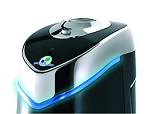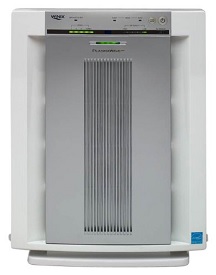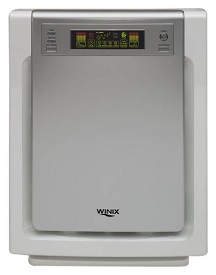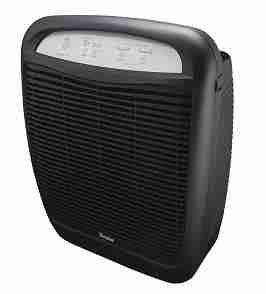Some links on this page are monetized by affiliate programs - see disclosure for details.
 With much of the world experiencing the onset of springtime, many people are finding themselves in the midst of a great struggle. On the one hand, there’s the warm weather and visions of outdoor fun, family gatherings, and the simple joys of the long, languid season to come, and on the other, a host of allergies and other nasty surprises crouch in wait, ever ready to ruin what should be a happy time.
With much of the world experiencing the onset of springtime, many people are finding themselves in the midst of a great struggle. On the one hand, there’s the warm weather and visions of outdoor fun, family gatherings, and the simple joys of the long, languid season to come, and on the other, a host of allergies and other nasty surprises crouch in wait, ever ready to ruin what should be a happy time.
Luckily, the advent of affordable, consumer grade air purification systems has made it possible for the average individual or family to enjoy themselves in healthful comfort all the year round. Of course, finding the best air purifier for your own unique situation and circumstances isn’t always simple. As luck would have it, we’ve created this handy primer on picking your own optimum air purification solution and hopefully get a, “breath of fresh air”. To get started, simply keep reading.
What Is An Air Purifier?
Contents
Simply put, an air purifier is exactly what it sounds like: a machine designed to remove any number of toxins, allergens, molds and fungi, pet-based irritants, and other related hazards from the air. As such, their primary market is that portion of the population which suffers from respiratory distress and/or diminished lung function brought on by allergies of all types, COPD (Chronic Obstructive Pulmonary Disease), advanced age, or some combination of other factors, but anyone who appreciates a breath of fresh air can benefit from owning a machine like this. Whether a purifier is of commercial or consumer grade is basically irrelevant in terms of overall construction; filtration methods may differ depending upon host facilities (a hospital versus a home), but overall size and design, the materials used in fabrication, and so forth hardly ever do. At any rate, modern air purification systems are of two main types:
* Small to mid-sized freestanding air purifiers that service a room (or sometimes multiple rooms)
* Large, industrial / commercial systems which are attached to a facility’s central HVAC system, and as such, service the entire building
Types of Air Purifiers on the Market
As stated above, beyond the comparatively slight variances in size, materials strength, and so on that delineate a residential or consumer product from a commercial or industrial one, the overall design of the modern air purifier is relatively simplistic and uniform. With that said, there is quite a lot of variety to be found in the methods by which these machines actually scrub the air they circulate. A brief explanation of the most prevalent air purification designs & techniques can be found below.
Filter Based
Air purifiers that work based on simple filtration – yes, the same principle that keeps your furnace or dryer clean and clear of lint or other particulate matter – are far and away the most widespread. Unsurprisingly, it’s also the cheapest and most low-maintenance solution available, at least in comparative terms. Suitable for both residential and commercial / industrial use, these machines operate via the principle of size exclusion. Air gets pushed through the filter(s) on the machine, and anything too large – anything larger than about three tenths of a micrometer – simply doesn’t make it through to the other side. Filtration based air purifiers can be found in two main sub-configurations:
High Efficiency Particulate Arrestance (HEPA) Filters, which are widely popular, greener (that is, more environmentally friendly) and slightly more effective when used properly.
Minimum Efficiency Reporting Value (MERV) Filter Systems, which are less well-known when compared to HEPA filtration systems, which is probably due to their diminished capacity for residential use – higher operational costs and the ability of users to compromise a MERV filter’s higher effectiveness from improper filter placement make them undesirable for the average consumer.
Ultraviolet Germicidal Irradiation
Dubbed UVGI for short, this filtration method works by forcing air past a set of ultraviolet (UV) lamps. This kills various pathogens, allergens, micro-organisms, and so forth by exposing them to a sufficiently lethal dose of the same radiation that pours forth from the Sun. Think of it as the mother of all sunburns, but on a micro scale. Dead matter is captured in a physical filter and removed during routine cleaning.
Thermodynamic Sterilization
While some air purifiers use this system to help clean the air, it’s improper to call it a filtration method as such, since it doesn’t actually parse out the irritants from the surrounding air. Instead, air is passed through a series of extremely hot ceramic coils and cooling plates (coil temperatures can reach 200 degrees Celsius / 392 Fahrenheit) which serves to first incinerate any offensive matter and then to cool the newly-cleansed air so that humans and animals can safely take it in.
Activated Carbon Filtration
While the use of activated carbon has been a popular choice for commercial air purification applications for a long time, it isn’t designed to remove physical matter from the air. Instead, like a stomach pump for the ether, activated carbon transforms gaseous toxins, irritants, and other such material into their respective solid phases. At that point, it’s up to a secondary filtration technology to screen them, lest they simply escape into the air (and the lungs) of the wider world.
Polarized Media Filtration (PMF)
In contrast to HEPA filtration and other such methodologies, which use time and passivity to do their work for them, this filtration technique is known as “active purification”, since it cleans the air on an ongoing, real time basis. This is accomplished through the electrical polarization of undesired materials – dust mites, spores of various types, pet dander, and any number of other irritants, allergens, and so on – by a persistent electric current. As the field passes through / over undesired objects in the air, they become polarized and, for lack of a better word, sticky. Said sticky particulates are drawn onto a disposable filtration pad where they, like the field that trapped them to begin with, exert a force on any ultra-fine matter – the extremely tiny particles which cause and carry unpleasant smells are one such example – that the field itself misses; the more filled the filter pad becomes, the larger and more powerful its biological magnet. Meanwhile, the field continues to generate and oscillate, collecting and trapping more matter as it goes, and the cycle persists in this manner until the air is cleansed.
Ionizers
Ionizers work in a similar fashion to PMF, but the technicalities are different. In the case of ionizer-based air purification, the machine creates ions from gas or ambient air, and these ions attach themselves to whatever needs filtering. These ion-clad particles are attracted to a collection plate for eventual removal. There are two types of ionizers:
Fanless ionizers are silent running and very energy efficient, but their air filtration capabilities are sub par, at least by comparison.
Ionizers equipped with fans prioritize air scrubbing force over aesthetics, and are therefore noisier and less efficient than their fanless counterparts.
Ozone Generators
The atom bomb of filtration technologies, these machines are designed to do one thing: Kill every particle of offensive matter within the confines of a building through the administration of a massive dose of ozone. It isn’t safe for people to breathe the gas emitted by ozone generators, so even though residential grade air filtration systems are different than the full-scale ozone generators discussed here, one should definitely think twice before buying an air purifier that produces it if you plan on using it in the home or office.
Titanium Dioxide Filtration
This method of air purification works by mixing nanoscale particles of the aforementioned element into common paint (along with some calcium carbonate for balance). The various forms of particulate matter that one would wish to rid himself or herself of make contact with the paint, and in so doing, are destroyed instantly. Think of it as a chemical bug zapper.
Advantages to Owning an Air Purifier
The advantages of owning an air purifier, whether it be a portable system for home use or a gigantic commercial / industrial setup, are almost harshly blunt: Do you enjoy breathing clean air, air which is free of all the nasty things that aggravate (or in some cases, even cause) allergies, respiratory problems, and so on? Then buy an air filter. Indeed, it may even be that your physician has written you a prescription for one; they are often used as part of the medical treatment given to patients with advanced breathing problems.
Read: The Ultimate Portable Air Conditioner
The Best Air Purifier on the Market: The Contenders
There are a staggering number of air purifiers on the market today, all of which are bedecked with a dizzying array of features, gimmicks, and marketing spin designed to secure the all-important sale. Obviously, not all of these devices are fit for every consumer; technology hardly ever conforms to the “one size fits all” mentality. To aid the readers of this review in their purchasing decision, the three best air purifiers for the most common demographics – best budget option, best value for money, and best overall entry – are briefly described below.
Best Budget Option: The Winix WAC5500
 For the budget conscious shopper looking for an air purifier of their own, the Winix WAC5500 True HEPA Air Cleaner from Winix is a great option.
For the budget conscious shopper looking for an air purifier of their own, the Winix WAC5500 True HEPA Air Cleaner from Winix is a great option.
Equipped with all the amenities that one ought to expect from a name brand provider (HEPA filtration, an Energy Star rating, and so on) as well as a few surprises like their proprietary PlasmaWave technology, this machine will serve quite well as a purification system for the bedroom, family area / living room, or even a smaller studio apartment, and it’ll do it without breaking the bank.
Best Value for the Money: The Winix WAC9500 Ultimate
 For those shoppers with a little more room, financially speaking, to strike a contrast between sticker price and feature set, there’s the Winix WAC9500 Ultimate. A step up from the WAC5500, this air purifier includes all of the features of the entry-level model while incorporating a few of its own – a pair of washable, reusable filters and auto / hands free operation, just to name a couple.
For those shoppers with a little more room, financially speaking, to strike a contrast between sticker price and feature set, there’s the Winix WAC9500 Ultimate. A step up from the WAC5500, this air purifier includes all of the features of the entry-level model while incorporating a few of its own – a pair of washable, reusable filters and auto / hands free operation, just to name a couple.
The Winix WAC9500 Ultimate is just the thing for freshening slightly larger rooms, apartments, or those homes which happen to be shared by a furry, four legged little friend.
Best Overall Option: The Whirlpool AP51030KB
 Sometimes, you just need – or is that want? – to splurge a little. The necessary cash outlay isn’t nearly as important as what you’re getting in return: top of the range features and specifications wrapped up in a sleek, visually pleasing package. When that time comes – assuming you’re in the market for an air purifier, that is – the Whirlpool AP51030KB will be waiting.
Sometimes, you just need – or is that want? – to splurge a little. The necessary cash outlay isn’t nearly as important as what you’re getting in return: top of the range features and specifications wrapped up in a sleek, visually pleasing package. When that time comes – assuming you’re in the market for an air purifier, that is – the Whirlpool AP51030KB will be waiting.
A small form factor hides a powerhouse – this unit is simultaneously brawny enough to handle large areas and silent enough as to be barely noticeable. With plenty of bells, whistles, and little extras to its name, this air purifier is sure to satisfy even the most discerning of customers.
Primary Considerations to Keep In Mind When Purchasing an Air Purifier
With all of the clamoring voices out there, it can be hard to make a final purchasing decision. After all, with every company in the air purification business telling you that theirs is the best option – the only option – worth considering, things can get a bit confusing. Throw in all the marketing glitz and technical details, and daunting hardly seems an adequate word to describe the pre-purchase jitters that can sweep over a person. Luckily, there’s a way to cut through all the haze. Simply keep the primary factors that make your tool (or whatever else you want to buy) worth something in the first place. In the case of air purifiers, those factors follow, with a brief explanation of how they apply to the three models outlined earlier.
Price
It seems simple to start out with price as a fundamental tenet of air purifier selection, but it’s necessary nevertheless. In addition to simple budgetary constraints, the price of a machine like this will have a direct bearing on what you actually end up with – cutting corners on features is a great way to keep manufacturer costs down, for example. Alternatively, true quality and convenience will always come with some mild sticker shock.
Performance
An air purifier is only as good as the extent to which it cleans the air that surrounds it. How much air an individual unit can clean, how quickly it accomplishes it, and the byproducts of the overall process are all things to consider when it comes to performance.
Features
Everyone likes a feature-rich product, but it’s important to make sure that the features attached to the air purifier you end up buying are helpful rather than detrimental. Additionally, some companies will attempt to trick customers with pseudo-features – “HEPA-like” filters are a popular con – or legitimate but superfluous extras.
Drawbacks
Cons. Negatives. Drawbacks. Whatever you choose to call them, all technologies have their flaws and weak spots, air purification systems being no exception. Prospective buyers of a machine like this should do what they can to familiarize themselves with potential weaknesses in their chosen product, balancing them against the unit’s good points / strengths in order to make a decision based upon the purifier as a whole.
Consideration-Based Product Breakdown
Price
Of good quality but relatively light on features, the Winix WAC5500 retails for approximately $150 USD.
Of similar quality but equipped with several user-friendly features not found in an entry-level unit, the Winix WAC9500 is designed to tackle bigger, tougher problems, and the price tag reflects that: $279 USD.
With multiple filters, the most pleasing visual and auditory profiles, and a bevy of user-centric features, the Whirlpool AP51030KB isn’t shy about attaching a premium price tag to this machine, retailing it for just north of $296 USD.
Performance
The three-stage filtration set-up used on the WAC5500 does a great job of cleansing smaller rooms. Construction is durable, and the remote control, while somewhat unwieldly, makes hands-free operation a snap.
Like its lower-cost brother, Winix, Inc.’s WAC9500 has a user-acclaimed “sleep mode” for nocturnal use, and its PlasmaWave ionization technology helps keep mid-sized rooms nice and fresh. Designed especially to tackle the needs of pet-friendly homes / customers.
Whirlpool’s AP51030KB has a HEPA filter that’s second to none, a great form factor and energy efficiency footprint (thanks, Energy Star!), and is capable of a solid CADR (Clean Air Delivery Rate) in rooms of 500 sq. ft. The controls and manuals are simple, too, which is a boon for the technologically disinclined.
Features
The entry-level WAC5500 is, rather surprisingly, full of features for its price point, including a reusable HEPA filter, multiple carbon filters, PlasmaWave technology, and a remote control for hands-free use.
Winix’s mid-range offering steps up the game, with the WAC9500 incorporating all of its younger sibling’s amenities, plus a quintuple-stage cleanse that’s specifically geared toward pet owners (some customers have reported this purifier doubling as a pet hair vacuuming system!).
The features on this Whirlpool air purifier are designed to make cleaning the air in even large rooms simple, quick, and effective. In combination with its multiple filters, this unit’s multi-speed fans (said fans include separate sleep and turbo settings in addition to their normal ranges) run on an Energy Star compliant motor, delivering a CADR of 500 square feet worth of safe, sweet air, give or take. Meanwhile, the simplistic controls and easy to read / decipher indicator lights make maintenance a breeze – and the generous warranty steps in even if you happen to break something.
Drawbacks
Winix’s WAC5500 isn’t bad in and of itself just because it’s an entry-level, bargain priced unit. Rather, it’s the comparative lack of features which makes this choice somewhat sparse. For instance, a lack of carrying handles or wheels makes moving the purifier from area to area a bit of a chore, though certainly not impossible. Additionally, some of the features it does boast can cause the machine to behave oddly (the WAC5500 won’t filter dust, pet hair, etc., and past customers report that the sensor which triggers a filtration cycle and/or power increase tends to be so sensitive as to be triggered by non-problems like food or nail polish).
Very surprisingly for the supposedly intermediate model from Winix, the WAC9500 actually delivers less power and air cleaning capacity (measured in square feet) than its budget counterpart. While it might be said that this unit is sacrificing raw strength for thoroughness required to clean pet odors and such, it’s something of a rude letdown to discover it’s a bit of a high-priced wimp. Also, this unit’s warranty is shockingly short given its intended use, coming it at just one year.
Cons in a top of the line unit like the Whirlpool model reviewed here are all the more damning for existing on a so-called elite model machine. Glaringly, the non-HEPA filters on the Whispure 510 / AP51030KB are basically trash according to customer reviews (including one from an HVAC professional). Another big ding to this machine is the shoddy customer service attached to it; past customers have reported issues with covered repairs, shipping, and so forth.
Closing Thoughts
While buying an air purifier you can be happy with over the long term can be something of a challenge without the proper information, this handy review guide should make it simple and quick. A final note: When purchasing a machine like this one, it’s important to balance its pros and cons so that you make an objective, complete buying decision based upon all the facts and evidence. For example, while the budget WAC5500 from Winix, Inc. will cost less up front, filter replacement costs will offset any savings when compared to the best overall pick on our list (the Whirlpool Whispure 510), which is saying quite a lot given the 510’s weak stock filters. In short, think critically, buy intelligently, and when in doubt, go for the best overall value, not just the item with the lowest price.
